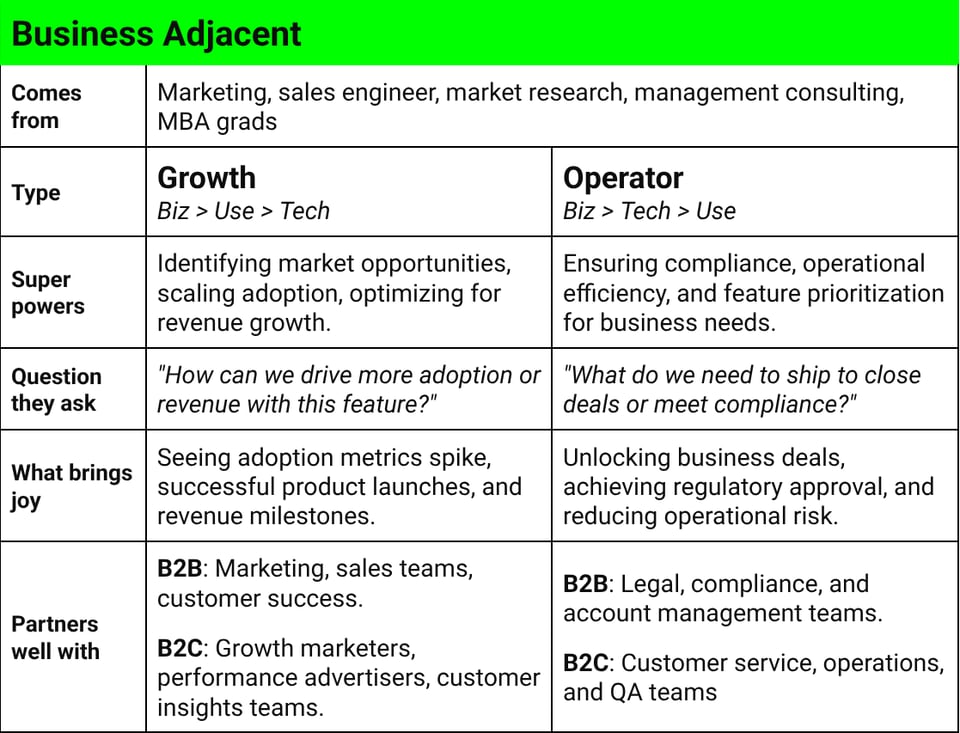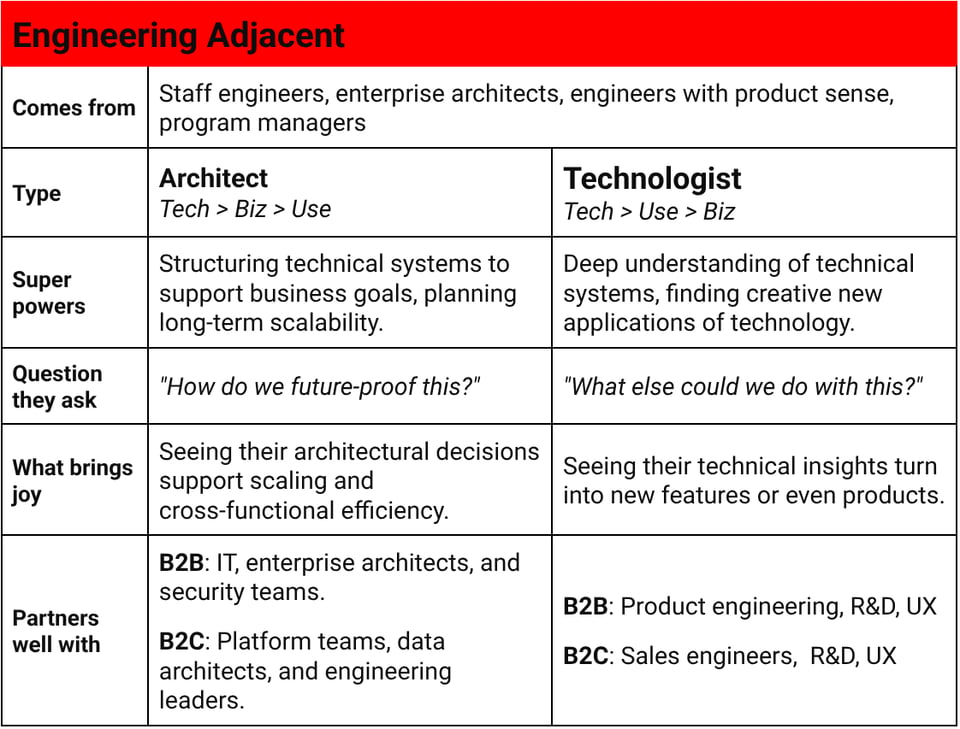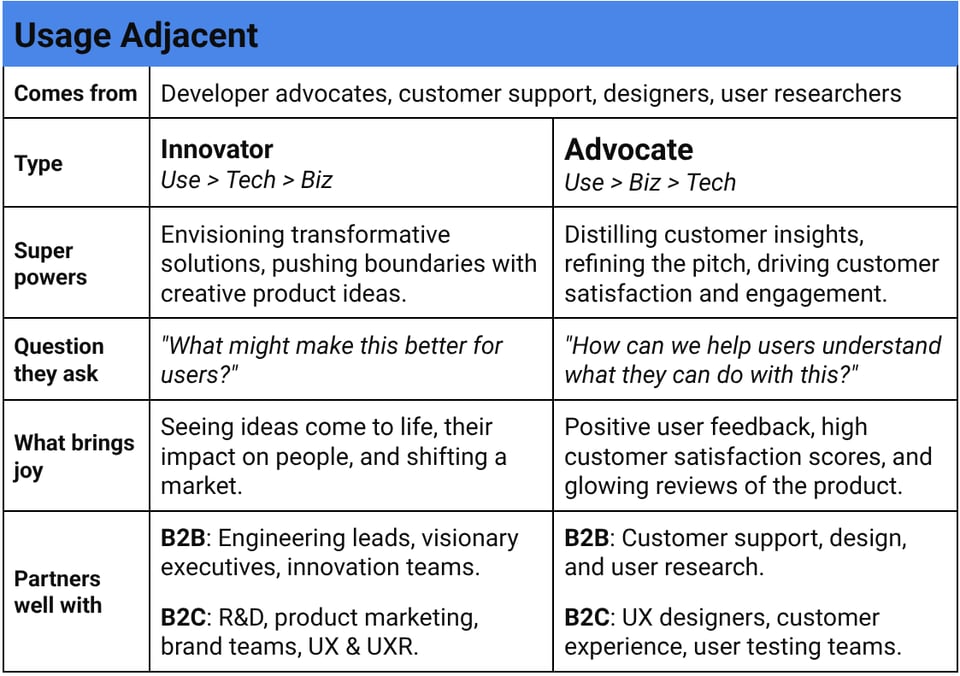Six flavors of product management
Use this framework to better understand your relative strengths as a product manager or in a product manager you work with. Identify the six distinct PM flavors and discover how each balances business, tech, and user needs.
What kind of a product manager are you? (If you're not a product manager, think about one you know.) What traits do you share with some PMs and not others?
Product management is weird. For years I have wrestled with ways to explain it to other people—even to other PMs! What has helped me is to divide it into six flavors, each with its own unique strengths and weaknesses.
Today I will explain how this approach helps me recognize the kinds of PM work that I will find most satisfying. By the end, you should be able to identify your flavor. This will give insights into your own strengths, to find roles that fit your style, and to collaborate more effectively with other PMs.
First, though, I must observe that THIS POST IS NOT JUST FOR PRODUCT MANAGERS. Product management happens whether you have someone who specializes in that role or not. While product management is (among other things) a balancing of competing forces, finding a balance is paramount. A good PM should be able to help.
The Management of Products
As I have written before, for any product to be viable (i.e., deserving of management) there must exist:
Problem — some issue that a potential customer needs to resolve
Solution — a way to address that problem
Transaction — a mutually-beneficial exchange of value
Repeatability — the machinery necessary to develop and produce those solutions again and again
When all of this happens, customers receive more value than they paid, employees get wages, and the business makes a profit.
The rest of this post will concentrate on the implications of the following diagram (a kind of iron triangle). Since my perspective comes from a tech-oriented world, “solutions” are represented by “Technology,” while the customer “problems” are represented as “Usage.” (note: while distinguishing people-who-actually-use from those-who-actually-buy is important but beyond the scope of this post!) Lastly, “Business,” is what is necessary to create the conditions for repeatable transactions (or what would be similar across all a number of competitors to make their businesses go).

When an organization is large enough to have a dedicated product manager role, the PM's field of play is the hexagon in the center. The adjacent three small triangles represent other domains: red (e.g., software engineers, architects, SRE); blue (e.g., design, UXR, CS), and green (e.g., marketing, sales, legal, HR, finance).
These red/blue/green triangles sit outside the PM territory. In each of those regions, a PM is a visitor. There are times where a PM may need to fill a short-term organizational gap, but that work has a large opportunity cost, since other PM work isn’t happening. (If this is you, and it makes you happier, great! Just consider a ladder change, maybe?)
Back to the hexagon—every PM's natural resting point is somewhere on the color gradient, depending on the relative pull of the three vertices. Notice how the corners of the hexagon have labels? Each one is an inflection point that represents an alignment extreme. There might even be dedicated roles for people in that space, for instance Architect or Advocate.
Each of those corners is an epitome of one type of PM. By definition, it is as far from one vertex as it can be without leaving the hexagon. For example, a Growth role will be less concerned with the technical solution than with the business and usage challenges. An Operator is more likely to focus on compliance-type features that can unblock deals.



Putting it together
My own journey into product management began by imagining technologies that I wished existed for myself. So I came in along the Usage <> Technology edge, closest to the Innovator. When I was a junior PM, I was suspicious of any PM who brandished their MBA. I winced when they prioritized the business view over usage or tech. This was because they were my diametric opposite. To be fair, they probably undervalued my contributions in a similar way. We both lacked the perspective to understand how these things fit together to form a trilemma.
Whatever PM type you most closely align with, it is likely easiest for you to switch into the type that shares a leg of the triangle with you. The next easiest would be the type that shares a vertex. The types that are two segments away may represent skills to develop over time. Your opposite, the type sitting directly across the hexagon, is likely where you are weakest. Consider partnering with someone who complements you in that area. And remember that strengthening these weaker skills may become valuable if your goal is to move up the PM ladder.
How might this shift over your career?
When a PM shifts from individual contributor (IC) into a leadership role in the product org, the center often pulls them toward it. This does not imply that one should aspire to be perfectly balanced! Understanding your own strengths will help you recognize what roles may bring out the best in you. Climbing the ladder further may pull you away from that, which is totally fine as long as you remain mindful of that.
This pull toward the center also happens to any non-PM leader who stays on their ladder (tech / use / biz triangles). Similarly, the higher they rise in the org chart, the more likely their job will bleed into other areas. Again, as the center pulls someone toward it, they become more removed from the detailed work in their original triangle.
What to do with this framework?
If you work with PMs, hopefully this helps you better understand the different flavors of product managers and how to engage with them more effectively.
If you are a PM, I hope this helps you better understand your natural tendencies. Ideally it also gives you a framework for finding people to partner with effectively or how to better identify roles you might enjoy.
If you manage PMs, think about how the different people on your team naturally align and where you might have gaps to fill in the short and long terms. If you do use this to drive conversations with your reports, I'm very curious to hear how it went!
Parting questions
Keep in mind that the triangle is an idealization. What if there are multiple products? Might some of the triangle legs be longer or shorter than others? How might those ratios shift over time? How might market forces affect them?
Special thanks to Isaac Hepworth, Pablo Kenney, Tim Burks, Michael Stein, Andrew Gunsch, Eric Wilfrid, Sarah Zaslow, and others who gave feedback, encouragement, and/or sharpened these ideas along the way.
-
I like this structuring Marsh - it definitely makes sense. You can probably apply the same lens to CEOs :-)! What's interesting I think is that different types of businesses/products actually need different types of PMs to function. So trying to find a "good PM" is not the right question, and for a PM it's also about finding the product where your particular skill set is most aligned.
Add a comment: